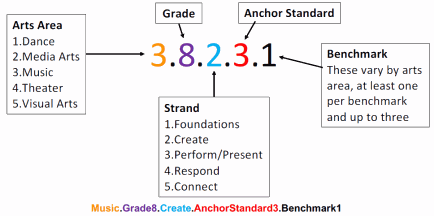Reading: Introduction to Minnesota Academic Standards in Arts
Arts Standards Background
Minnesota is in the process of adopting the 2018 Academic Standards in the Arts. They are to be implemented by the 2021-22 school year. The next review of the arts standards will occur during the 2027-28 school year.
The 2018 Academic Standards in the Arts set the expectations for achievement in arts education for K-12 students in Minnesota. These standards include five arts areas: dance, media arts, music, theater, and visual arts. The overarching goal of the arts standards is the development of artistic literacy for all Minnesota students. Artistic literacy is defined as “the ability to combine foundational knowledge and skills in an art form with four processes fundamental to the arts: Creating, Performing or Presenting, Responding, and Connecting.”
Organization of the Standards
The organization and structure of the 2018 arts standards illustrate how arts education is conceptualized for Minnesota students. Each benchmark has a 5-digit code. For example:
Code |
Arts Area |
Grade |
Strand |
Anchor Standard The student will… |
Benchmark The student will… |
3.8.2.3.1 |
3. Music |
8 |
2. Create |
3. Create original artistic work. |
Develop a composition in a specific form that includes expressive elements using notation or recording technology. |

1. Arts area (1st digit in code). The five arts areas are: dance, media arts, music, theater, and visual arts.
2. Grade level (2nd digit). 0 = Kindergarten; 1 = 1st grade, etc. HS = high school 9-12 grade band.
3. Strand (3rd digit). The standards are organized into five strands. Strands are big concepts or practices into which standards are grouped. They help communicate some of the most important aspects of learning in a content area. The five strands represent four artistic process and foundational knowledge and skills.
4. Anchor standard (4th digit). There are ten arts standards. Academic standards describe the expectations in arts learning that all students must satisfy to meet state requirements for credit and graduation. An anchor standard is a broad statement of the most important learning in a content area, kindergarten through twelfth grade. They are the same for all five arts areas.
5. Benchmark (5th digit). The benchmarks provide details about “the academic knowledge and skills that schools must offer and students must achieve to satisfactorily complete” the anchor standards. Each standard is supported by one or more benchmark. Benchmarks are unique to each arts area.
a. Benchmarks are grade level for kindergarten through 8th grade. The 9-12 grades benchmarks are grade banded. These describe the years’ worth of learning that should occur in the one arts credit required for graduation.
b. Anchor standard #1 in the Foundations strand has no benchmarks listed below it. Instead, foundations are integrated across the benchmarks in the other strands. Text is bolded where foundational knowledge and skills are present in other benchmarks.
c. Each standard and benchmark begins with the phrase, “The student will…” Examples provided in the benchmarks are intended to clarify the meaning of the benchmark and are optional.
d. The 2018 arts standards include a glossary of terms referenced in the standards for each arts area. Italics in a benchmark indicate that the word or phrase is included in the glossary.
Foundational Documents for the Arts Standards
The 2014 National Core Arts Standards were adapted by the Minnesota Arts Standards Review Committee to become the 2018 Minnesota Academic Standards in the Arts. Additional documents used in the development of the arts standards include:
Foundational Research, Reports, and Best Practices
National Coalition for Core Arts Standards. (2014). National Core Arts Standards: A Conceptual Framework for Arts Learning.
National Assessment of Educational Progress (NAEP). (2016). National Assessment of Educational Progress (NAEP) 2016 Arts Framework, Chapter 2, The Content and Processes of the Arts.
The College Board. (2011). A Review of Selected State Arts Standards.
The College Board. (2013). International Standards for Arts Education: A review of standards, practices, and expectations in thirteen countries and regions.
The College Board. (2012). College-level Expectations in the Arts.
President and Fellows of Harvard College. (2003). Studio Thinking/Artist Habits of Mind.
Recently developed standards from the national level and other states
National Coalition for Core Arts Standards. (2014). National Core Arts Standards.
Utah State Board of Education. (2016). Utah Fine Arts Standards.
Illinois State Board of Education. (2016). Illinois Arts Standards.






